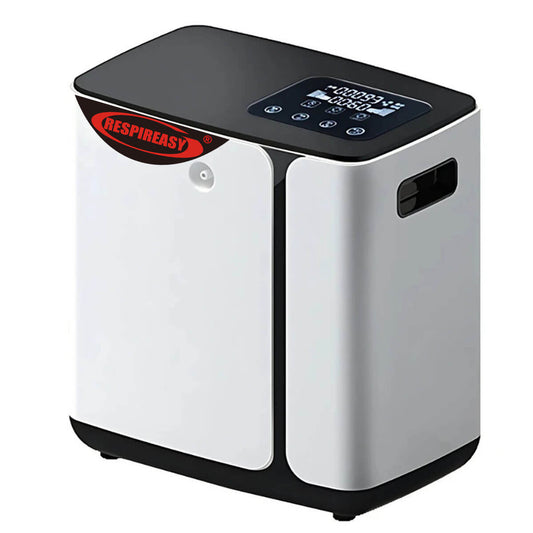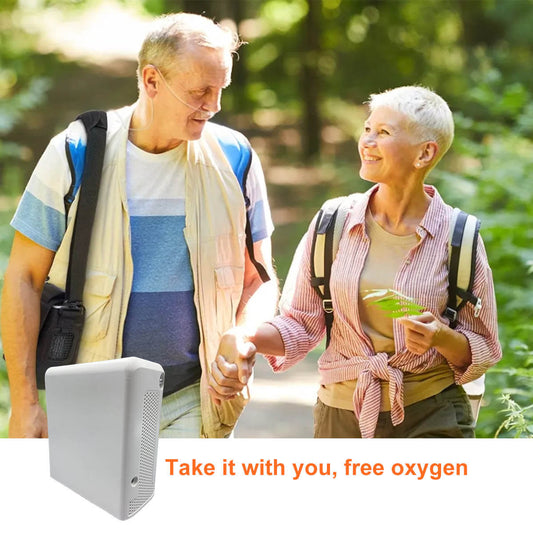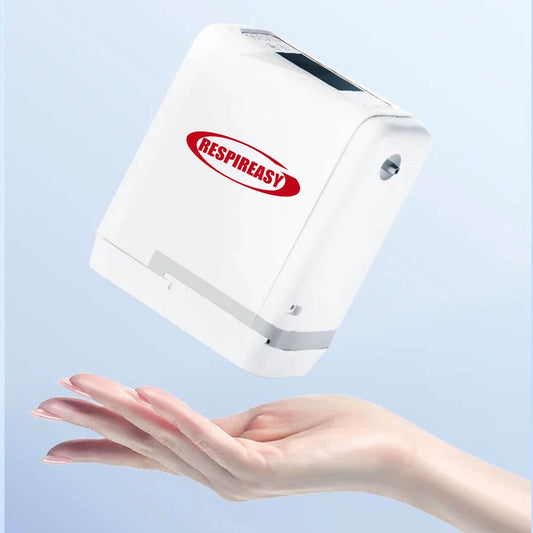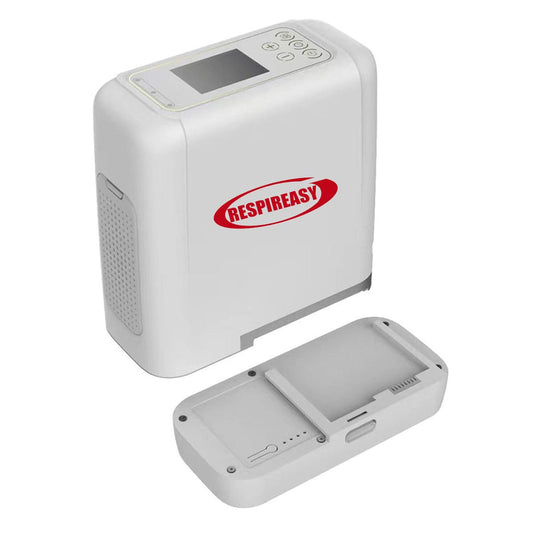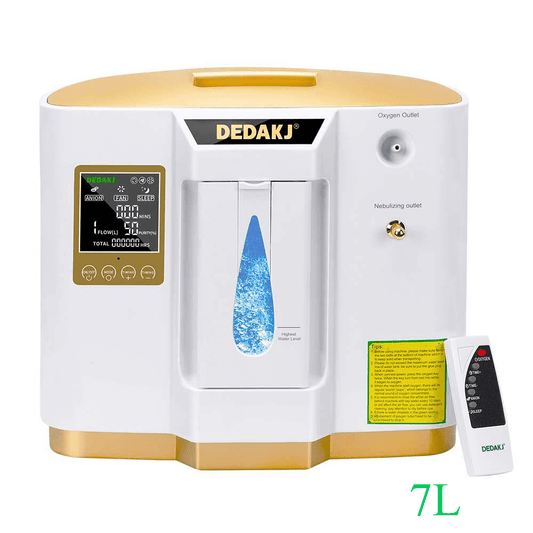¿Cuáles son los problemas más comunes al utilizar un concentrador de oxígeno en casa? ¿Cuáles son los malentendidos sobre la inhalación de oxígeno en casa?
Concentrador de oxígeno DEDAKJ
Actualmente, muchas familias han preparado concentradores de oxígeno, especialmente aquellas con hipoxia. Con la llegada del otoño y el invierno, las personas con opresión en el pecho, dificultad para respirar, bronquitis crónica y enfermedades pulmonares comenzaron a usar concentradores de oxígeno para inhalar oxígeno.
¿Cómo ajustar el flujo al usar un concentrador de oxígeno? ¿Cómo solucionar diversos problemas, como el ruido anormal de la máquina y la falla del concentrador de oxígeno en la producción de oxígeno? Incluso se preguntan: "¿La inhalación prolongada de oxígeno causará dependencia del oxígeno? ¿Cuánto tiempo se necesita inhalar oxígeno al día?".
DEDAKJ: Una institución profesional para marcas de servicio terminal de concentradores de oxígeno y ventiladores, especialmente reimprimiendo el conocimiento popular de los concentradores de oxígeno del sitio web oficial del Centro de Verificación de la Administración Nacional de Medicamentos, una autoridad nacional, para compartir y popularizar.
¿Cuáles son los problemas comunes en el uso de concentradores de oxígeno?
¿Cuáles son los malentendidos más comunes en la inhalación de oxígeno en el hogar?
1. ¿Es normal que el concentrador de oxígeno haga un sonido de "soplo...soplo..."?
Cuando el concentrador de oxígeno de tamiz molecular está funcionando, se oirá un soplo regular (generalmente cada 8 segundos aproximadamente). Este es el sonido normal del cambio de tamiz molecular.
2. Durante el uso, ¿cuánto flujo de oxígeno se debe ajustar por minuto?
El flujo de oxígeno debe ajustarse según las indicaciones del médico. El flujo de oxígeno variará según el grado de hipoxia. Las personas que reciben oxigenoterapia para la enfermedad pulmonar obstructiva crónica (EPOC) deben... Generalmente, se recomienda usarla a bajo flujo durante un tiempo prolongado. Siga las indicaciones del médico.
3. Al usar el concentrador de oxígeno, aparecen burbujas en el vaso de humidificación. ¿Por qué no hay oxígeno en el tubo de oxígeno?
Verifique si hay fugas en la conexión del recipiente de humidificación y el tubo de oxígeno, y verifique si el respiradero del recipiente de humidificación está bloqueado por sarro.
4. Al usar el concentrador de oxígeno, la temperatura en su base es particularmente alta. ¿Se puede seguir usando?
El compresor del concentrador de oxígeno de tamiz molecular se calienta durante el funcionamiento, lo cual es normal. Se recomienda colocar el concentrador de oxígeno en un lugar ventilado durante su uso y está estrictamente prohibido cubrirlo.
5. Uso del concentrador de oxígeno. Después de un tiempo, noté que el flujo de aire se ha reducido. ¿Qué sucede?
Revise el filtro de entrada de aire del concentrador de oxígeno, limpie el filtro de primer nivel o reemplace el de segundo nivel cuando sea necesario, y limpie la tubería interna del humidificador para evitar la obstrucción por sarro. Se recomienda reemplazar el filtro del concentrador de oxígeno DEDAKJ cada 2 a 4 meses. Para obtener un reemplazo, comuníquese con el fabricante.
6. ¿Cómo saber la concentración de oxígeno después de haber utilizado el concentrador de oxígeno durante un período de tiempo?
Los concentradores de oxígeno profesionales suelen contar con indicadores de concentración de oxígeno y alarmas de baja concentración. Si es necesario, puede contratar a un proveedor de servicios de venta de concentradores de oxígeno para detectar y verificar los diversos indicadores del concentrador.
7. ¿Se puede seguir utilizando el concentrador de oxígeno si hay un sonido anormal o una alarma anormal?
Si el concentrador de oxígeno emite un sonido anormal o un sonido de alarma anormal, se recomienda dejar de usarlo y comunicarse con el proveedor de servicios de ventas de DEDAKJ para una inspección o reparación oportuna.
8. ¿Es normal que el ruido del concentrador de oxígeno se vuelva más fuerte después de algunos años de uso?
Los concentradores de oxígeno de tamiz molecular generalmente utilizan compresores para comprimir el aire. Tras un uso prolongado, el recipiente de cuero del compresor se desgastará y el ruido aumentará gradualmente. Esto suele ser normal.
¿Cuáles son los malentendidos más comunes sobre la inhalación de oxígeno en el hogar?
Malentendido 1:
Cualquiera puede inhalar oxígeno, lo que no sólo puede tratar enfermedades sino también brindar atención médica.
La oxigenoterapia es un método de tratamiento altamente profesional. Los concentradores de oxígeno son dispositivos médicos de Clase II. Además de su uso en instituciones médicas, los concentradores de oxígeno pequeños pueden utilizarse para el tratamiento auxiliar domiciliario en condiciones de hipoxia ambiental y patológica, como la hipoxia meseta, enfermedades respiratorias graves y enfermedades cardiovasculares y cerebrovasculares. Sin embargo, los concentradores de oxígeno para tratamiento auxiliar domiciliario no deben utilizarse para soporte vital ni para garantizar la vida.
Este producto debe usarse bajo supervisión médica y de acuerdo con el horario de uso diario y el caudal para reducir el riesgo de una indicación incorrecta. Actualmente no hay evidencia de que la inhalación de oxígeno tenga efectos beneficiosos para la salud en personas normales. Por el contrario, la inhalación inadecuada de oxígeno puede causar daños al cuerpo humano.
Malentendido 2:
La inhalación de oxígeno a largo plazo provocará dependencia o adicción al oxígeno.
2. La supervivencia humana requiere la inhalación de oxígeno del aire mediante la respiración. En circunstancias normales, el oxígeno del aire puede satisfacer las necesidades del cuerpo humano. Cuando el cuerpo humano no puede inhalar completamente; el contenido de oxígeno en el aire es insuficiente, se bloquea el proceso de entrada de oxígeno a la sangre. Cuando la capacidad de las células humanas para utilizar el oxígeno de la sangre disminuye, se produce hipoxia.
La hipoxia se refiere a una serie de cambios patológicos causados por un suministro insuficiente de oxígeno o un trastorno en la utilización del oxígeno en los tejidos humanos, lo que provoca cambios en el metabolismo funcional del cuerpo e incluso en la estructura morfológica.
La inhalación de oxígeno a largo plazo sirve para complementar el oxígeno que el cuerpo humano necesita debido a la hipoxia causada por enfermedades relacionadas. Las personas sanas, en condiciones normales, que respiran aire de forma natural, no desarrollan dependencia ni adicción al oxígeno.
Malentendido 3:
La inhalación prolongada de oxígeno provocará intoxicación por oxígeno.
3. La intoxicación por oxígeno se refiere a los cambios patológicos en la función y estructura de ciertos sistemas u órganos después de que el cuerpo inhala oxígeno en alta concentración por encima de cierta presión durante un cierto período de tiempo.
La concentración de oxígeno de salida de un generador de oxígeno general es del 93 ± 3 %, pero no corresponde a la concentración de oxígeno inhalado en los alvéolos. Al utilizar un generador de oxígeno estándar con un tubo de inhalación de oxígeno tipo π, la concentración de oxígeno inhalado está relacionada con el ajuste del flujo, es decir: concentración de oxígeno inhalado = 21 + (4 veces el caudal). Por lo tanto, al inhalar oxígeno durante un tiempo prolongado, debe seguir las recomendaciones del médico para ajustar el flujo de oxígeno y la frecuencia diaria de inhalación. Los métodos incorrectos de inhalación de oxígeno pueden causar efectos secundarios o intoxicación por oxígeno.
Malentendido 4:
La inhalación de oxígeno se puede ajustar a voluntad independientemente de la condición, y el flujo y el tiempo de oxígeno se pueden ajustar a voluntad.
4. La inhalación de oxígeno, también conocida como oxigenoterapia, consiste en administrar oxígeno a través de una fuente que cumple con el estándar de oxígeno médico, aumentar la presión parcial de oxígeno arterial (PaO₁) y la saturación arterial de oxígeno (SaO₂), aumentar el contenido de oxígeno arterial (CaO₂), corregir la hipoxia causada por diversas causas y promover el metabolismo tisular. Es un método de tratamiento altamente profesional.
Por lo tanto, la inhalación de oxígeno debe seguir el consejo del médico y ajustar científicamente el flujo de oxígeno y el tiempo de inhalación de oxígeno de acuerdo con la indicación de hipoxia, la presión parcial de oxígeno arterial o la saturación de oxígeno en sangre.
Malentendido 5:
Siempre que sea un concentrador de oxígeno, se puede utilizar para oxigenoterapia.
5. Los concentradores de oxígeno para oxigenoterapia domiciliaria (de 1 a 3 litros) tienen efectos médicos y de atención médica, y solo son utilizados por personas con enfermedades respiratorias leves, como estudiantes, embarazadas, ancianos y trabajadores administrativos. Los concentradores de oxígeno de 5 a 20 litros tienen importantes efectos médicos y son adecuados para pacientes con enfermedades respiratorias y pulmonares, y con necesidades especiales de inhalación de oxígeno y oxigenoterapia. Asimismo, se puede utilizar una máquina de oxígeno de alta presión de 20 litros o más con una cámara de oxigenoterapia hiperbárica, lo cual resulta muy práctico para realizar oxigenoterapia hiperbárica en casa.































